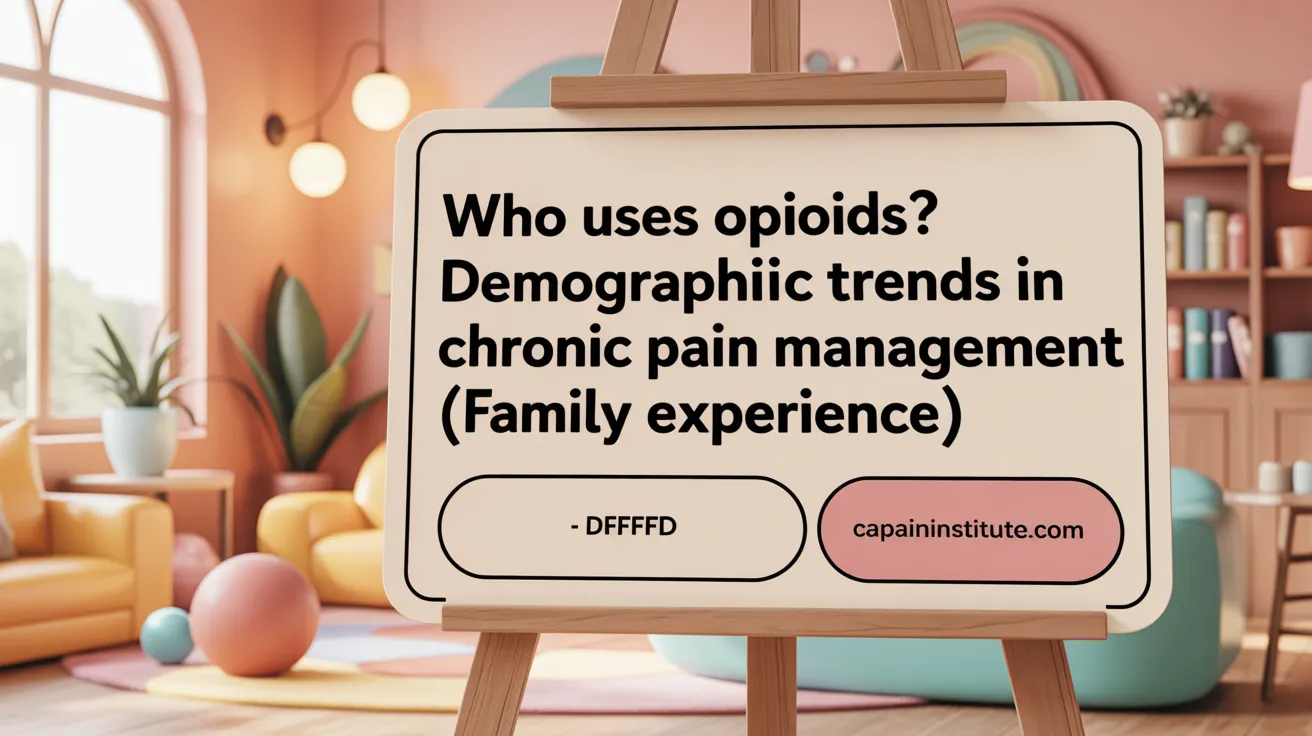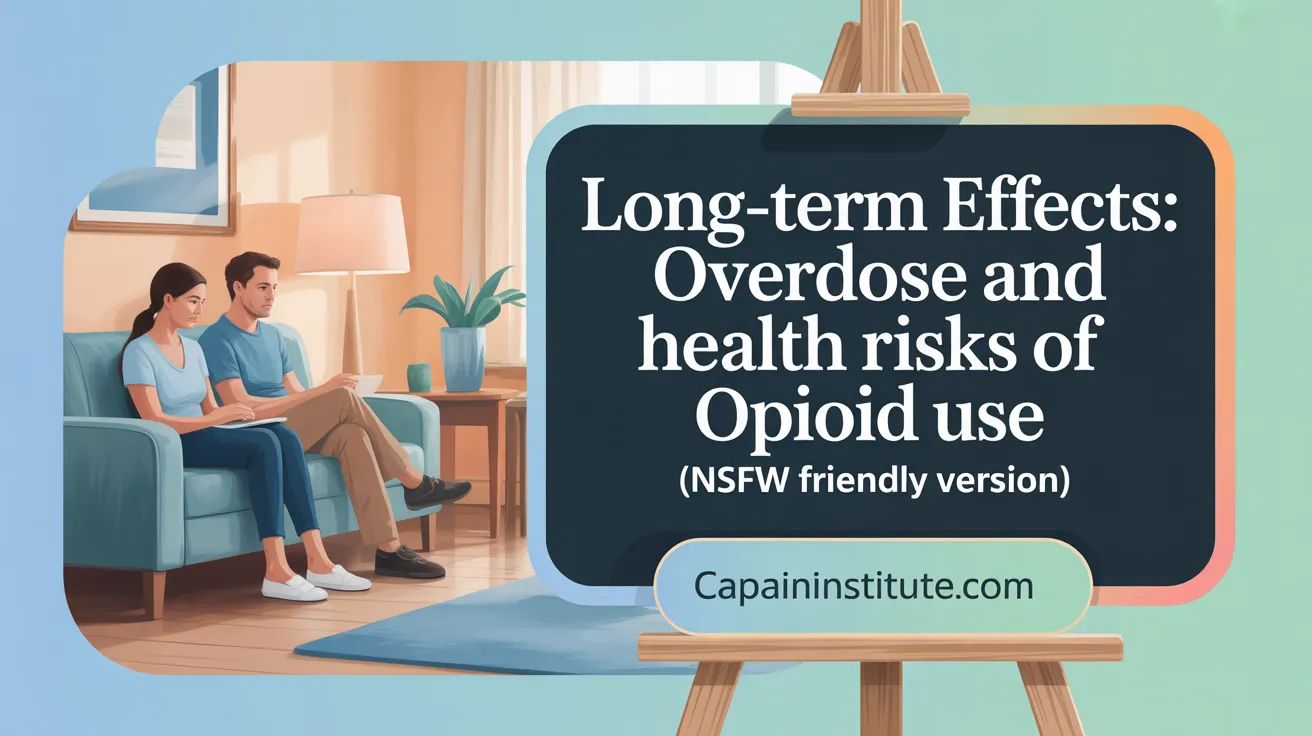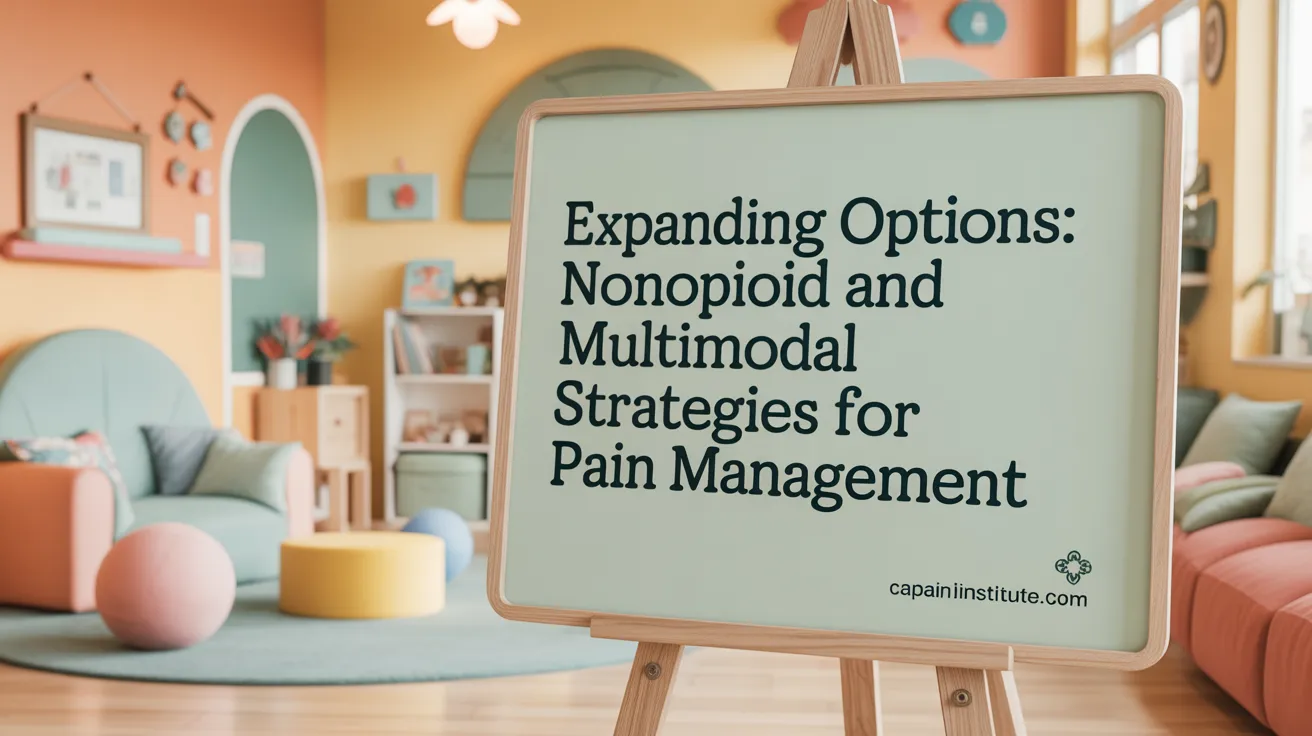Understanding Opioid Use in Chronic Pain Management
Chronic pain affects a substantial portion of the U.S. population, often leading to complex treatment challenges. Opioids have been a cornerstone in managing chronic noncancer pain, but evolving evidence and policy changes are reshaping prescribing practices. This article delves into opioid prescription statistics related to chronic pain management, examining trends, demographic patterns, safety concerns, guideline impacts, and health system responses to inform ongoing efforts towards safer and more effective pain care.
<!-- VIDEO:eyJsaW5rIjoiaHR0cHM6Ly93d3cueW91dHViZS5jb20vd2F0Y2g/dj0zcW50ZjM3c0FfZyIsImltYWdlVXJsIjoiaHR0cHM6Ly9lbmNyeXB0ZWQtdGJuMC5nc3RhdGljLmNvbS9pbWFnZXM/cT10Ym46QU5kOUdjUWUtUmFpVndNT1VIU01NcXZHZjVfZk1iNUNjQ2Q3dG9ZcUFCOVVpc2NneDljNl9KUW5kc0VieXlzZmppU3AmcyZlYz03MzA4NjEzOSIsInRpdGxlIjoiUGFpbiBwb2ludHM6IE5hdmlnYXRpbmcgdGhlIG9waW9pZCBjcmlzaXMiLCJzbmlwcGV0IjoiLi4uIGRhdGEsIHBvbGljeSBzaGlmdHMsIGFuZCBjbGluaWNhbCBzdHJhdGVnaWVzIHRoYXQgY2FuIGhlbHAgZG9jdG9ycyBiYWxhbmNlIHBhaW4gbWFuYWdlbWVudCB3aXRoIGFkZGljdGlvbiBwcmV2ZW50aW9uLiBUaGlzIGVwaXNvZGUgd2FzIC4uLiJ9 -->Prevalence of Chronic Pain in the United States

National prevalence estimates of chronic pain
In the United States, chronic pain affects a significant portion of the adult population. As of 2011, approximately 11.2% of adults—around 25.3 million people—reported experiencing pain daily. The Institute of Medicine (2011) estimated that about 100 million adults suffer from chronic pain, although this figure varies depending on survey methods.
Impact on quality of life and comorbidities
Chronic pain is not just a persistent discomfort; it often accompanies other health problems that further impair quality of life. People with chronic pain frequently experience issues such as impaired memory, sleep disturbances, and reduced physical functioning. These conditions can lead to increased mental health challenges, greater social isolation, and a decline in overall well-being.
Additional insights
The widespread prevalence of chronic pain highlights its importance as a public health concern. It influences healthcare costs, productivity, and individual health outcomes. Understanding the scope of this issue underscores the need for effective management strategies that consider both pain relief and the reduction of associated health risks.
Demographics of Opioid Use Among Chronic Pain Patients

What proportion of adults with chronic pain are prescribed opioids?
In the United States, approximately 22.1% of adults experiencing chronic pain reported using prescription opioids within the past three months, based on data from 2019. This indicates that nearly one in five adults with ongoing pain relies on opioids as part of their pain management strategy.
Usage rates are not uniform across all populations. Women tend to use opioids more frequently than men, with 24.3% of women and 19.4% of men with chronic pain using these medications. Age is another influential factor, with adults aged 45–64 showing the highest prevalence of opioid use at around 25.9%. Usage tends to slightly decrease in those aged 65 and older.
Socioeconomic status also plays a significant role. Adults with less than a high school diploma or GED have the highest prevalence of opioid use at 26.2%, suggesting that lower educational attainment correlates with higher prescription rates. Income levels impact use as well, with those below 100% of the federal poverty line displaying a higher prevalence (about 27%) compared to higher-income groups.
Insurance coverage influences opioid prescribing patterns. Adults with Medicare or Medicaid are more likely to be prescribed opioids than those who are uninsured. Specifically, Medicaid enrollees have a usage rate of approximately 28.4%, while uninsured adults have a considerably lower rate of about 12.1%.
Overall, while roughly 1 in 5 adults with chronic pain receive opioids, these figures fluctuate based on demographic variables such as age, gender, education, income, and insurance status. These disparities highlight the need for tailored approaches in pain management and careful assessment of prescribing practices across different population groups.
| Demographic Factors | Percentage of Chronic Pain Patients Using Opioids | Additional Notes |
|---|---|---|
| Gender (Women) | 24.3% | Slightly higher than men |
| Gender (Men) | 19.4% | Overall lower usage |
| Age (45–64 years) | 25.9% | Highest prevalence among age groups |
| Education (<High School) | 26.2% | Correlation with lower educational attainment |
| Income (<100% Federal Poverty) | 27% | Higher usage among lower-income groups |
| Insurance (Medicare/Medicaid) | ~28.4% (Medicaid), ~28.2% (Medicare) | Higher prescribing rates |
| Uninsured | 12.1% | Significantly lower than insured groups |
This snapshot of opioid use among adults with chronic pain underscores significant demographic differences, emphasizing the importance of context-specific pain management strategies.
Historical Trends in Opioid Prescribing for Chronic Pain

What are the national trends in opioid prescription rates over recent years?
Over the past decade, there has been a significant shift in the volume and strength of opioids prescribed for chronic pain in the United States. In 2011, approximately 206 million opioid prescriptions were dispensed, marking a peak in the prescribing trend. These prescriptions primarily targeted conditions like arthritis, back pain, and other noncancer pain syndromes.
However, in subsequent years, efforts to address the opioid crisis led to a notable decline in the number of prescriptions. By 2019, the total prescriptions had decreased to around 191 million, a 44% reduction from the peak. This decline was driven by updated clinical guidelines, increased awareness of overdose risks, and the implementation of monitoring programs like Prescription Drug Monitoring Programs (PDMPs).
Between 2011 and 2019, the focus shifted from prescribing larger quantities of opioids to more cautious, individualized approaches. The guidelines emphasized lower doses, careful reassessment, and a preference for nonopioid therapies when possible. Despite overall reductions, some areas, such as prescribing stronger opioids like oxycodone and fentanyl, saw an increase, raising concerns about residual risk of overdose and dependence.
Geographically, prescription rates varied considerably across states. Southern states like Arkansas and Alabama experienced the highest rates, with approximately 71.5 prescriptions per 100 persons in 2019. Conversely, states like Hawaii and California maintained much lower rates, around 22-23 prescriptions per 100 persons. This variation reflects differences in local prescribing practices, healthcare access, and socioeconomic factors.
The decline in prescriptions paralleled a transformation in overdose patterns, with illicit opioids like heroin and synthetic fentanyl now accounting for a larger share of overdose deaths since 2012. Nonetheless, prescription opioids remain a contributing factor, especially in cases involving high-dose therapy or long-term use.
Recent data also show an increase in the use of medications like buprenorphine for opioid use disorder (OUD), with prescriptions rising by approximately 92% from 2016 to 2019. This shift signifies a transition from prescribing opioids purely for pain management towards addressing opioid dependence and overdose prevention.
In summary, national opioid prescription trends demonstrate a move from high-volume prescribing towards more cautious practices, but the persistence of geographic disparities and continued overdose deaths highlight ongoing challenges in balancing effective pain management with safety.
Opioid Use Disorder and Risk of Misuse in Chronic Pain Patients
Is there a relationship between chronic pain and the risk of opioid misuse or abuse?
There is a well-established connection between chronic pain and an increased likelihood of opioid misuse or abuse. Patients enduring long-term pain often turn to opioids for relief, but these medications can also address emotional suffering, which may elevate the risk of developing substance use disorders. This is especially true when opioids are used extensively over time.
Research shows that the longer and more intensively opioids are used for chronic noncancer pain, the greater the chance of misuse, dependence, and overdose. As opioid prescribing ramped up in the late 20th century, new issues of addiction and misuse emerged, contributing significantly to the current opioid crisis. Vulnerable populations include individuals with a history of mental health issues, prior substance abuse, or certain genetic predispositions.
Clinicians employ various screening tools to evaluate the potential for misuse before initiating opioid therapy. The Opioid Risk Tool (ORT) is commonly used to assess personal and family history of substance abuse, previous mental health diagnoses, and other factors that increase risk. These assessments help providers identify at-risk patients and tailor their management plans accordingly.
To prevent misuse and manage risks effectively, healthcare providers use ongoing monitoring strategies. These include regular re-evaluation of pain and function, urine drug testing to verify compliance and detect unauthorized substance use, and review of prescription drug monitoring program (PDMP) data. Multidisciplinary approaches, including psychological support and addiction treatment when necessary, further enhance the safety and efficacy of pain management.
Overall, understanding and addressing the relationship between chronic pain and opioid misuse is crucial for balancing effective pain relief with minimizing the potential harms of opioids. Proper assessment and vigilant monitoring are essential tools in this effort, helping to curb misuse while ensuring patients receive appropriate care.
Efficacy of Opioids in Managing Chronic Pain: Short-Term vs. Long-Term
How effective are opioids in managing chronic pain?
Opioids are widely used to provide quick relief from pain, especially for individuals suffering from chronic non-cancer conditions such as arthritis and back pain. Many patients experience significant pain reduction shortly after starting opioid therapy, which can improve comfort and daily functioning.
However, when it comes to long-term management, the evidence becomes much less clear. Most clinical trials assessing opioids for chronic pain are short-term, typically lasting less than four weeks. These studies demonstrate the analgesic benefits of opioids in the immediate term but do not offer conclusive proof that they sustain pain relief or improve physical function over months or years.
Lack of long-term efficacy studies
There is a notable absence of robust, long-term research evaluating the effectiveness of opioids for chronic pain management. No comprehensive, controlled studies spanning over a year have conclusively shown that opioids lead to better pain control, enhanced functioning, or improved quality of life compared to other treatment strategies.
This gap in data raises concerns because chronic pain is a persistent condition that often requires sustained management. Without evidence supporting long-term benefits, the continued use of opioids becomes questionable, especially considering the potential for adverse effects.
Functional outcomes and quality of life implications
While opioids can temporarily relieve pain, their long-term use has been linked to various negative health outcomes. These include increased risks of fractures, cardiovascular issues, hormonal imbalances, and overdose. Furthermore, long-term opioid therapy does not necessarily translate into better functional outcomes or enhanced quality of life. Instead, some patients may experience increased disability, mental health challenges, and risks of dependency.
Consequently, healthcare providers are encouraged to consider alternative, multimodal approaches to pain management, such as physical therapy, behavioral therapy, and non-opioid medications, which may offer safer and more sustainable benefits.
| Aspect | Short-Term Effectiveness | Long-Term Evidence | Additional Considerations |
|---|---|---|---|
| Pain Relief | Significant and immediate | Limited; sustained relief uncertain | Rapid tolerance development; dose escalation risks |
| Functional Improvement | Usually improved temporarily | Not well-supported by long-term data | Risk of increased morbidity from adverse effects |
| Quality of Life | Can improve briefly | No clear evidence for lasting improvement | Risks may outweigh benefits over time |
Though opioids can serve as effective short-term tools, their role in long-term management remains limited and controversial. Ongoing research continues to weigh the modest benefits against substantial risks, guiding clinicians toward more cautious and individualized pain management strategies.
Long-Term Risks and Harms Associated with Opioid Therapy

What is the overdose risk and how does it relate to opioid therapy?
Long-term opioid use carries a notable risk of overdose and mortality. Data estimates show that the annual risk of death associated with opioid treatment doses above 100 Morphine Milligram Equivalents (MME) is approximately 0.25%. This risk increases significantly with higher dosages, especially doses exceeding 80 to 120 mg/day, which require careful assessment and often consultation with a pain specialist.
Overdose deaths related to prescription opioids peaked in 2010, with over 16,000 lives lost annually. While initial increases in prescription rates contributed to the epidemic, recent policies and guidelines have aimed to reduce prescribing and, consequently, overdose risks. Despite these efforts, opioid-related deaths continue to be a major public health concern, with populations aged 35–54 experiencing the highest mortality rates—often surpassing deaths from firearms and motor vehicle accidents.
Are there other health outcomes linked to long-term opioid therapy?
Beyond overdose risk, prolonged opioid use is associated with various other serious health outcomes. Studies suggest increased risks of fractures, which may be due to impaired balance or bone density changes, and cardiovascular events such as myocardial infarctions. Additional harms include hormonal disruptions, increased vulnerability to motor vehicle accidents, and psychological effects like increased mental health issues.
These adverse outcomes highlight the importance of cautious prescribing, ongoing patient assessment, and vigilant monitoring, especially for patients on higher doses or long-term therapy.
How do dose thresholds influence harm?
The relationship between opioid dose and risk of adverse effects is dose-dependent. Higher doses, particularly above 100 MME per day, have been linked with a ninefold increase in overdose risk. Consequently, clinical guidelines recommend that dose escalation be approached with caution, and doses above 80–120 mg/day should involve comprehensive risk assessments and consideration of alternative pain management strategies.
Monitoring tools such as urine drug testing, prescription monitoring programs, and patient education about overdose prevention with naloxone are crucial components of harm reduction for patients on long-term opioids. Recognizing these dose thresholds helps healthcare providers balance effective pain relief with minimizing the potential for severe harms and mortality.
Impact of Opioid Dosage on Safety and Outcomes

What are Morphine Milligram Equivalent (MME) thresholds?
Morphine Milligram Equivalent (MME) is a standardized way to compare the potency of different opioids. Clinicians convert prescribed doses into MMEs to assess the relative strength and potential risk of opioid medications. The CDC recommends that doses exceeding 90 MMEs per day should be prescribed cautiously, with thorough risk assessments and consideration of alternatives. Doses above 100 MMEs significantly elevate the risk of overdose and adverse events.
What are the risks associated with high-dose opioid use?
Using higher doses of opioids increases the likelihood of serious health problems, including overdose and death. Doses over 100 MMEs are linked with approximately a ninefold increased risk of overdose. In addition to overdose, high doses are associated with increased risks of fractures, cardiovascular issues, hormonal imbalances, and motor vehicle accidents. These risks necessitate careful evaluation and ongoing monitoring when higher doses are considered.
What are the current recommendations for dose limits and specialist consultation?
To mitigate risks, many guidelines recommend limiting initial opioid dosages and regularly reassessing the benefits versus harms. For doses approaching or exceeding 90-120 MMEs per day, prescribers should seek consultation with a pain or addiction specialist. Tapering of opioids should be gradual, typically around 10% per month, with close monitoring for withdrawal symptoms and pain management effectiveness.
| Thresholds (MME) | Risk Level | Additional Recommendations |
|---|---|---|
| 50-90 | Moderate | Careful monitoring, consider alternatives |
| 90-120 | High | Consult specialist, consider tapering |
| >120 | Very High | Urgent review, risk mitigation strategies |
Customizing dosing plans and involving specialists when needed can help balance effective pain control with patient safety.
Safety Monitoring in Opioid Prescribing for Chronic Pain

Use of risk assessment tools
Effective safety monitoring begins with thorough risk assessment before initiating opioid therapy. Healthcare providers should evaluate factors like history of substance use disorder, mental health issues, and social environment. Tools such as standardized questionnaires can identify patients at higher risk for misuse or overdose. Incorporating risk assessment into initial consultations helps tailor individualized treatment plans and informs decisions about prescribing opioids.
Regular patient reassessment and documentation
Ongoing evaluation of patients on opioids is vital. Clinicians should conduct regular follow-ups to monitor pain levels, functional status, and potential adverse effects. Documentation of these assessments ensures consistent tracking of the patient's progress and compliance with best practices. Routine review should also include adjusting doses, exploring alternative therapies, and considering tapering or discontinuation if risks outweigh benefits.
Urine drug testing and Prescription Drug Monitoring Programs (PDMP)
To prevent misuse and diversion, urine drug testing is recommended periodically, especially for long-term therapy. These tests can confirm adherence, detect non-prescribed substances, or identify early signs of misuse.
Additionally, PDMPs are state-based electronic databases that record controlled substance prescriptions. Clinicians should consult PDMPs regularly to review patients' prescription histories and identify patterns such as doctor shopping. These practices are crucial in promoting safe prescribing, reducing overdose risk, and ensuring patients are receiving appropriate care.
Combining risk assessments, consistent reassessments, and utilization of monitoring tools provides a comprehensive approach to enhance safety in opioid prescribing while addressing the complexities of managing chronic pain.
Clinical Guidelines Influencing Opioid Prescribing Practices

What is the role of the 2016 CDC opioid prescribing guidelines?
The 2016 CDC guidelines serve as a critical resource for healthcare providers managing patients with chronic noncancer pain. These guidelines aim to balance effective pain treatment with safety measures to reduce the risk of opioid misuse, overdose, and addiction. They provide evidence-based recommendations on how to prescribe opioids responsibly, emphasizing the importance of considering nonpharmacologic treatments first and using opioids only when necessary.
What are recommended approaches for nonpharmacologic pain management?
Nonpharmacologic treatments are recommended as the initial approach for many chronic pain conditions. These include physical therapy, increasing physical activity, psychological therapies such as cognitive-behavioral therapy, and alternative modalities like acupuncture. These strategies can help reduce reliance on opioids and improve patient outcomes without exposing them to the risks associated with long-term opioid use.
How should opioid dosages be managed under the guidelines?
The guidelines advise cautious use of opioids, especially emphasizing that prescribing doses should be limited to avoid high-dose therapy, which is associated with increased risks. Specifically, they recommend that clinicians should generally avoid increasing dosages above 90 Morphine Milligram Equivalents (MME) per day.
Patients on long-term opioid therapy should undergo regular reassessment, including evaluating the effectiveness of treatment and potential risks. Tapering opioids gradually—typically about 10% per month—is recommended for patients where the risks outweigh the benefits or if adverse effects emerge.
In situations where high doses are necessary, clinicians are advised to involve pain specialists, utilize prescription drug monitoring programs, and consider co-prescription of naloxone to prevent overdose.
Additional safety strategies highlighted by the guidelines
- Regularly review patient history and current medication use through monitoring tools like urine drug testing and prescription drug monitoring programs.
- Screen for substance use disorder and mental health issues.
- Document and communicate treatment plans clearly.
- Special considerations should be taken for vulnerable populations such as older adults, pregnant women, and individuals with a history of substance use disorder.
By adhering to these guidelines, healthcare providers can provide safer, more effective pain management, helping to curb the ongoing opioid crisis while addressing patient needs.
Effects of CDC Guidelines on Opioid Prescribing Patterns

Changes in opioid prescription volumes post-2016
Since the release of the CDC guidelines in 2016, there has been a noticeable decline in the number of opioid prescriptions across the United States. For instance, opioid prescriptions dispensed from outpatient pharmacies decreased from a peak of 206 million in 2011 to about 169 million in 2015, and further down to 191 million by 2017. This trend reflects increasing efforts to curb excessive prescribing, which contributed to the opioid crisis.
In addition, Medicaid enrollees receiving opioid prescriptions for pain dropped from 11.3% in 2016 to 7.2% in 2019. Overall, the prescribing rates for high-risk opioids, particularly those for chronic pain, have been reduced as prescribers adapted to new guidelines emphasizing cautious use.
Increase in nonopioid pain medication use
aligned with these changes, there has been a significant shift toward prescribing nonopioid pain treatments. Insurance claims data from 2011 to 2018 reveal that prescriptions for nonopioid pain medications, including NSAIDs, antidepressants, and anticonvulsants, increased annually after the guideline release. By 2018, rates of nonopioid prescriptions rose by 9.7%, with the most considerable increases seen in patients with chronic pain.
This move aims to provide safer, evidence-based alternatives to opioids, reducing the risks of overdose, dependence, and side effects associated with long-term opioid therapy.
Impact on clinical practice and policy
The guidelines have influenced clinical practices nationwide, promoting strategies such as risk assessment, regular monitoring, and individualized treatment plans. Implementation of Prescription Drug Monitoring Programs (PDMPs) has become widespread, helping healthcare providers track controlled substance prescriptions and prevent misuse.
Moreover, policy measures like removing the X-waiver requirement for buprenorphine and increasing access to medication-assisted treatment reflect a broader commitment to combat opioid misuse. Healthcare providers now prioritize nonopioid approaches initially and reserve opioids for cases where benefits outweigh risks, with careful dose and duration considerations.
Overall, these policy shifts and practice adaptations aim to balance effective pain management with minimizing opioid-related harms, including overdose and dependence.
| Aspect | Pre-2016 Trends | Post-2016 Changes | Description |
|---|---|---|---|
| Prescription Volumes | Rising; 206 million peak in 2011 | Decreasing; 191 million in 2017 | Reflects efforts to reduce overprescribing |
| Nonopioid Use | Increasing gradually | Significant increase; 9.7% rise | Greater adoption of nonopioid treatments |
| Policy and Practice | Less emphasized | Widespread monitoring and guidelines | Improved safety, tailored care |
Regional and Demographic Variations in Opioid Prescribing

How do prescription rates vary across different regions in the United States?
In the United States, opioid prescribing patterns exhibit notable geographic disparities. States in the South and Appalachia tend to have higher prescription rates compared to Western states. These differences are influenced by regional variations in healthcare practices, socioeconomic factors, and the prevalence of chronic pain conditions. For example, in certain rural areas, physicians may prescribe opioids more frequently due to limited access to alternative pain management options.
How do differences by race, ethnicity, age, and sex impact opioid prescribing?
Research shows that demographic factors significantly influence opioid prescription patterns. Women are more likely than men to receive opioid prescriptions for pain, with women accounting for about 24.3% of prescriptions versus 19.4% for men. Age also plays a crucial role, as adults aged 45–64 have the highest prevalence of opioid use at approximately 25.9%, with rates decreasing slightly in those 65 and older.
Ethnic disparities are evident as well. Non-Hispanic White adults are more likely to receive opioid prescriptions, with about 14% of this group filling prescriptions in recent years. In contrast, Hispanic and non-Hispanic Black populations report significantly lower prescription rates, around 7%–13%. These differences may partly result from systemic factors such as disparities in healthcare access or provider biases.
What role do social and systemic factors play?
Social determinants and healthcare system issues heavily influence opioid prescribing disparities. Income levels, education attainment, insurance status, and geographic location shape access and decision-making in pain management. For example, individuals with lower income levels or less than a high school diploma are more likely to receive opioids, possibly due to fewer alternatives or healthcare resources.
Additionally, systemic factors such as provider training, local prescribing norms, and the availability of nonpharmacologic treatments contribute to variation. The increased use of Prescription Drug Monitoring Programs (PDMPs) aims to address these disparities by tracking prescriptions and reducing misuse, but disparities still persist, emphasizing the need for targeted interventions.
| Demographic & Geographic Factors | Prescription Patterns | Impact & Considerations |
|---|---|---|
| Geographic Disparities | Higher in South & Appalachia | Influenced by provider practices, access |
| Race & Ethnicity | Higher among Non-Hispanic Whites | Systemic healthcare inequalities |
| Age | Peak in 45–64 years | Overlap with chronic pain prevalence |
| Sex | Women more likely to receive opioids | Gender-based healthcare differences |
| Income & Education | Higher in lower-income, less educated | Limited access to alternative therapies |
Understanding these variations is essential for developing equitable pain management strategies and addressing the ongoing opioid crisis.
Medicaid Enrollees and Opioid Prescription Trends

How have opioid prescriptions among Medicaid enrollees changed over time?
Between 2016 and 2019, there was a marked decline in opioid prescriptions for Medicaid recipients, reflecting a nationwide effort to curb excessive opioid use. The percentage of Medicaid enrollees receiving at least one opioid prescription for pain dropped from 11.3% in 2016 to 7.2% in 2019. This reduction aligns with updated clinical guidelines and policies aimed at promoting safer prescribing practices.
What disparities exist in pain management and treatment access?
Even with overall declines, disparities persist in opioid treatment access and prescribing patterns. Data show that White enrollees are more likely to receive opioid prescriptions than Black and Hispanic populations. For instance, White enrollees saw the largest increases in treatment prescriptions during this period. Additionally, socio-economic factors influence access: adults with lower incomes and less education have higher prevalence of opioid use.
How has buprenorphine prescribing for opioid use disorder evolved?
There has been a significant rise in medications used to treat opioid use disorder (OUD). Prescriptions for buprenorphine, a medication that helps manage OUD and prevent overdose, increased by 92% from 2016 to 2019. By 2019, buprenorphine accounted for 87% of all prescriptions aimed at treating OUD or reversing overdose, demonstrating an increased focus on expanding access to effective treatments.
| Aspect | Changes Over Time | Additional Details |
|---|---|---|
| Prescription decline | 2016-2019: drop to 7.2% | Reflects policy changes and guidelines |
| Disparities in treatment | Whites more likely to receive opioids | Socioeconomic and racial disparities exist |
| Buprenorphine prescriptions | 92% increase (2016-2019) | Major component of OUD treatment programs |
This pattern indicates a shift in Medicaid and overall healthcare practices toward safer, more targeted use of opioids, along with increased efforts to provide medication-assisted treatment (MAT) for addiction. Continued addressing disparities and expanding access remains essential to combat the ongoing opioid crisis.
Integration of Nonopioid Pain Management Strategies

What are the recent trends in prescribing nonopioid medications?
In recent years, there has been a notable increase in the prescribing of nonopioid pain medications such as NSAIDs, antidepressants, and anticonvulsants. These medications are increasingly used as first-line treatments for managing chronic pain, especially following the release of guidelines advocating for more cautious opioid use. For example, prescribing rates for NSAIDs, which are effective for conditions like arthritis, have risen by several percentage points in the years after guideline updates.
Antidepressants and anticonvulsants, originally designed for other conditions like depression and epilepsy, respectively, are recognized for their role in neuropathic pain relief. Their prescribing has also seen an upward trend, reflecting efforts to diversify pain management options and reduce reliance on opioids.
How is the shift towards multimodal pain therapy shaping treatment?
This transition to multimodal pain therapy involves combining different types of medications and nonpharmacologic interventions to provide more comprehensive pain relief. The goal is to optimize pain control while minimizing side effects and risks associated with high-dose or long-term opioid therapy.
Clinicians now frequently recommend a combination of physical therapy, psychological support, and nonopioid medications tailored to individual patient needs. This approach not only addresses the physical aspects of pain but also considers mental health, mobility, and overall quality of life.
What are the benefits and challenges of implementing these strategies?
Implementing multimodal and nonopioid strategies offers several benefits, including reduced opioid prescriptions, lower risk of addiction, and potentially better long-term pain outcomes. Patients often experience fewer adverse effects, such as gastrointestinal issues from NSAIDs or cognitive effects from antidepressants.
However, challenges remain in clinical practice. These include ensuring adequate training for healthcare providers in multimodal pain management, managing patient expectations, and overcoming systemic barriers like insurance coverage limitations. Additionally, some nonopioid medications have their own risks and side effects that require careful monitoring.
As data continues to support the safety and effectiveness of these approaches, ongoing education and policy adjustments are vital to facilitate their broader implementation in chronic pain management.
Opioid Therapy in Vulnerable Populations
Older adults and risk factors
Older adults represent a growing segment of those prescribed opioids for pain management. Data from 2020-2021 indicates that approximately 12.8% of adults aged 65 and older filled at least one outpatient opioid prescription. This population often has multiple health issues, and pain is common among those in poor health, with 27.0% of such individuals using opioids. However, they are also at increased risk for adverse effects such as falls, fractures, and cognitive impairment related to opioid use. Higher prescription rates are observed among non-Hispanic White and Black elders, especially those with Medicare and low-income backgrounds. Since older adults often have comorbidities requiring complex medication regimens, careful assessment of the necessity, dosage, and monitoring are essential to minimize harm.
Considerations for pregnant women and pediatric patients
Pregnant women and children require special attention when considering opioid therapy due to potential risks. For pregnant women, opioids can affect fetal development and increase risks of neonatal abstinence syndrome. Therefore, opioids during pregnancy should be prescribed with caution, emphasizing the lowest effective dose and close monitoring. Pediatric patients present unique challenges; their developing bodies and brains are more susceptible to adverse effects of opioids, and long-term impacts on development remain an area of concern. For these populations, nonpharmacological pain management strategies are often preferred, and if opioids are necessary, usage should be carefully tailored with vigilant assessment.
Implications for patients with mental health disorders
Individuals with coexisting mental health disorders (MHD) such as depression or anxiety are more likely to receive opioid prescriptions, with about 34% of adults with both pain and MHD receiving an opioid within two weeks of diagnosis. These patients tend to have higher usage rates and may be at greater risk for misuse and dependence. Studies show that opioid prescriptions for pain are nearly twice as common among those with MHD compared to those without. Managing these patients requires a comprehensive approach, including mental health assessment, cautious prescribing, and integration of behavioral health strategies to reduce potential for misuse and support responsible pain management.
Health System Responses and Policy Developments Addressing Opioid Use
Prescription Drug Monitoring Programs
To combat opioid misuse and overdose, many U.S. states have implemented Prescription Drug Monitoring Programs (PDMPs). These electronic databases track controlled substance prescriptions across providers and pharmacies, helping clinicians identify potential misuse, doctor shopping, or diversion. The widespread adoption of PDMPs aims to improve prescribing practices by providing real-time data, thereby enabling healthcare providers to make more informed decisions, reduce unnecessary prescriptions, and enhance patient safety.
Elimination of X-waiver for buprenorphine
In efforts to increase access to treatment for opioid use disorder (OUD), recent policy changes have eliminated the X-waiver requirement for prescribing buprenorphine, an effective medication used in medication-assisted treatment. This regulatory shift allows more healthcare providers to prescribe buprenorphine without specialized training, thereby expanding treatment capacity, especially in underserved areas. Increasing access to OUD medications helps address the ongoing overdose crisis and improves recovery outcomes.
Naloxone co-prescription and education initiatives
Naloxone is a life-saving medication that can reverse opioid overdoses. Recognizing its importance, health systems have promoted co-prescribing naloxone alongside opioids at higher doses or for individuals with elevated overdose risk. Education initiatives are also in place to inform prescribers and patients about the proper use of naloxone, overdose recognition, and response. These strategies aim to reduce overdose deaths by ensuring emergency reversal options are readily accessible and used effectively.
| Policy Measure | Description | Impact |
|---|---|---|
| PDMPs | Electronic tracking systems for controlled substances | Reduce misuse and doctor shopping |
| X-waiver removal | Liberalizes prescribing of buprenorphine | Expand access to OUD treatment |
| Naloxone initiatives | Co-prescription and educational programs | Lower overdose fatality rates |
Efforts at the policy and health system level continue to evolve, emphasizing safer prescribing practices, expanding treatment access, and increasing overdose prevention measures to address the ongoing opioid epidemic.
Role of Education and Provider Training in Opioid Prescribing

Provider adherence to clinical guidelines
Ensuring that healthcare providers follow established clinical guidelines is crucial for safe opioid prescribing practices. These guidelines emphasize starting with non-opioid therapies when possible, carefully assessing patient risks, and prescribing the lowest effective doses for the shortest necessary duration. By adhering to these standards, providers can minimize the risk of overdose, dependence, and misuse.
Training on opioid risk mitigation
Specialized training programs targeting prescribers focus on risk mitigation strategies, including regular patient assessments, monitoring through urine drug testing, and prescribing naloxone as a precaution against overdose. Training also covers recognizing signs of misuse and addiction, allowing providers to intervene early. These educational efforts are added to improve prescribing safety and to comply with federal and state regulations.
Effectiveness of de-implementation strategies
Studies have demonstrated that comprehensive de-implementation strategies can reduce excessive opioid prescribing. For example, a recent project involving targeted training and clear prescribing protocols led to a 6% reduction in daily opioid doses among patients with chronic pain in primary care settings. These strategies often include provider education combined with system-level supports such as decision aids and monitoring tools, which help reinforce safe prescribing behaviors.
Overall, education and ongoing provider training are essential components in combating the opioid crisis. They facilitate the transition toward safer prescribing practices, reduce potential harms associated with opioids, and support the broader effort to manage chronic pain effectively without increasing overdose risks.
Economic and Social Costs of Inadequate Chronic Pain Treatment

Morbidity and mortality due to undertreated pain
Chronic pain affects millions of Americans, with estimates reaching up to 100 million adults impacted in 2011. When pain is not properly managed, it leads to significant health consequences, including increased risks of overdose, cardiovascular issues, fractures, and even death. Studies have shown that long-term opioid therapy, often used for chronic noncancer pain, is associated with serious risks such as overdose and opioid abuse, especially at higher doses. These health complications contribute to higher morbidity and mortality rates among individuals with poorly managed pain.
Functional limitations and mental health impact
Individuals with unmanaged or undertreated chronic pain often experience profound functional limitations. Pain hampers their ability to perform daily activities, work, and engage socially, leading to diminished quality of life. Additionally, chronic pain is linked to mental health issues like depression, anxiety, and sleep disturbances. These mental health conditions can exacerbate pain perception and create a vicious cycle, further impairing an individual’s overall well-being.
Financial burden on healthcare systems
The financial costs associated with inadequately treated chronic pain are substantial. Medical expenses rise due to frequent healthcare visits, emergency care, and hospitalizations related to pain complications and overdose incidents. The widespread prescription of opioids, despite their limited long-term efficacy, contributes to increased healthcare spending. Moreover, the societal impact includes lost productivity and increased disability claims, placing a heavy economic strain on healthcare resources and social support systems.
| Aspect | Impact | Additional Details |
|---|---|---|
| Morbidity and mortality | Elevated risk of death and serious health complications | Long-term opioid use linked to overdose and cardiovascular issues |
| Functional and mental health | Reduced daily functioning, mental health disorders | Depression, sleep disturbances, decreased quality of life |
| Healthcare costs | Increased medical spending and societal economic burden | Emergency care, hospitalizations, productivity loss |
Addressing these challenges requires effective pain management strategies, better risk assessment, and policies aimed at reducing unnecessary opioid exposure while ensuring access to adequate pain relief.
Future Directions: Research and Policy Needs in Opioid Use for Chronic Pain

Need for long-term opioid efficacy studies
Current research on opioids for chronic pain primarily focuses on short-term outcomes, often not extending beyond six weeks. This leaves a gap in understanding the long-term benefits and risks associated with sustained opioid therapy. Long-term studies are vital to assess whether opioids genuinely improve function, reduce pain, and do so safely over extended periods. Without this data, clinicians remain uncertain about the true value of opioids in managing chronic pain and risk inadvertently increasing adverse health outcomes.
Innovative pain treatments
The high prevalence of chronic pain and the associated risks of opioids highlight the urgent need for new treatment options. Advancements in non-pharmacologic therapies, including physical therapy, psychological interventions, and nerve stimulation techniques, offer promising alternatives. Development of medications with fewer side effects and lower addiction potential is also critical. Invested research into understanding pain mechanisms could reveal novel targets for therapy, ultimately expanding the toolkit for pain management that is both effective and safer.
Balanced approaches to minimizing risks while improving pain care
Efforts to address the opioid epidemic emphasize balanced strategies that prioritize patient safety without compromising pain relief. Guidelines now recommend cautious prescribing, regular monitoring, and patient education on overdose prevention, complemented by tools like urine drug testing and prescription monitoring programs. Policymakers and healthcare providers are encouraged to implement comprehensive frameworks that incorporate risk assessment, personalized treatment plans, and access to addiction treatment resources, such as medications for opioid use disorder.
| Aspect | Current Focus | Future Needs | Impact |
|---|---|---|---|
| Research | Short-term efficacy | Long-term studies on safety and benefit | Better patient guidance |
| Treatments | Opioids, limited alternative options | Development of novel, safer therapies | Reduced dependency and improved outcomes |
| Policies | Prescribing guidelines, monitoring | Holistic approaches, education, and access to treatment | Safer prescribing practices |
Progress in these areas can help reconcile the necessity of effective pain management with the imperative to prevent overdose and addiction, ultimately leading to better health outcomes for millions suffering from chronic pain.
Toward Balanced and Safer Opioid Use in Chronic Pain Care
The landscape of opioid prescribing for chronic pain has undergone significant evolution marked by a peak in use followed by cautious declines driven by robust guideline implementation and policy changes. While opioids remain an important option for short-term relief, their long-term benefits are unproven and counterbalanced by substantial risks, including misuse, overdose, and adverse health outcomes. The variability in prescribing across demographics and regions highlights ongoing disparities and the need for targeted interventions. Comprehensive approaches integrating risk assessment, patient monitoring, education, and access to alternative therapies show promise in improving management of chronic pain. Continued research into effective, safe pain treatments and policies that balance patient needs with safety concerns is essential to address this persistent public health challenge.
References
- CDC Clinical Practice Guideline for Prescribing Opioids for Pain
- Pain Management and the Opioid Epidemic - NCBI Bookshelf
- Opioids and Chronic Pain: An Analytic Review of the Clinical Evidence
- [PDF] Guidelines for Prescribing Controlled Substances for Pain
- A Look at Changes in Opioid Prescribing Patterns in Medicaid ... - KFF
- The Effectiveness and Risks of Long-Term Opioid Therapy for ...
- Opioids for chronic noncancer pain - Neurology.org
